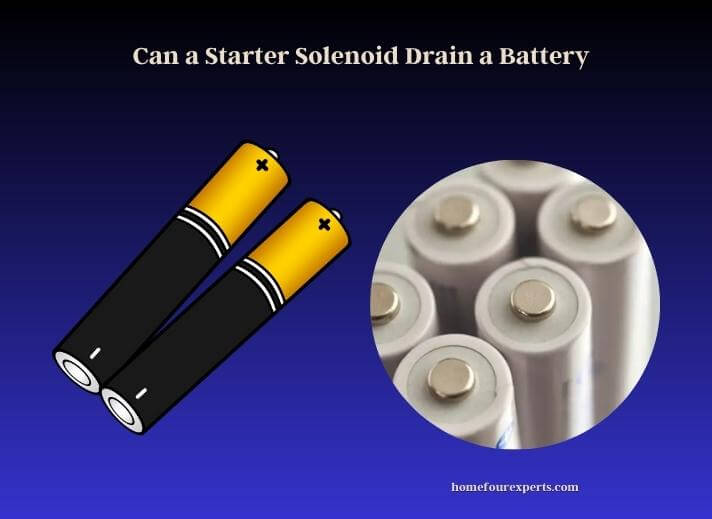For the starter to function correctly, power must be transferred from the battery to the solenoid. It’s a really straightforward procedure. But if it’s faulty, then the operation might not be that simple. Those facing the car battery drain after a day of sitting often ask, ‘can a starter solenoid drain a battery?‘
Not all starter solenoids drain a battery; with a faulty starter, a solenoid might result in a gradual battery drain. Although it is rare for the starter solenoid to fail, it can be destroyed by hot temperature, humidity, or poor connections. Fortunately, the starter solenoid will warn you before it fails.

An insufficient battery charge causes a starter solenoid to fail and generate a clicking noise. That time it pressures the battery and gradually drains it. This writing discusses the most typical symptoms of a faulty starter solenoid and the most common causes of solenoid damage.
We also discuss its impact on battery and a guide for replacing your starter solenoid on your own to save money.
The Function of Starting Solenoid
One of the most neglected but crucial components of the ignition system is the starter solenoid. The starting solenoid receives battery power from the starter relay and engages the starter. As a result, the electrical line is incomplete without a starter relay, and the engine will not start. Read more: Can a Completely Dead Battery Be Recharged
The starter solenoid can supply a magnetic wave to provide the requisite mechanical force to move the gear and deliver power flow. The engine’s rotation starts when the gear moves. The starter solenoid is built to last, and it is pretty rare for it to fail.
Signs of a Bad Starter Solenoid
Next, you need to know what are the signs of a bad starter solenoid. There are several frequent indicators of a faulty starter solenoid; some are simple to spot, while others are more difficult to spot and require a certain level of observance. Look for the following possible indicators of a failed or damaged starter solenoid:
1. There might be one of the reasons that your car might not start, and that is the solenoid.
2. You can hear a single and repeated clicking sound from the engine or underneath the vehicle. This could indicate that the solenoid is attempting to activate but cannot do so because structural parts are stuck.
3. Instead of restricting the engine from starting, a defective starter solenoid may force it to start itself without turning the key to the start position. This less-common issue is potentially harmful and should be handled right away.
4. If the starter starts but does not disengage when the key is removed, the solenoid is broken, and the starter may be seriously damaged.
5. Your car will start several times, but not all of the time. A faulty starter solenoid might cause inconsistent performance.
Causes of Bad Starter Solenoid
A defective starter solenoid can be caused by a variety of factors, including:
1. A Problem With the Wiring
In your vehicle’s starting system, loose or incorrectly connected wires are pretty prevalent. As these wires deteriorate, the starter solenoid will not receive the proper amount of current, causing it to be damaged.
2. Heat Generation Issues
The starter solenoid is not designed to withstand large currents for long periods since the high current generates a lot of heat, which might harm the solenoid. It is predicted to be damaged because the starter solenoid is exposed to a high current for an extended time when the ignition switch is on.
3. Excessively Tightened Bolt
You don’t need to overtighten the starter solenoid for any reason. You risk breaking or bending the starter solenoid’s bolts if you over-tighten them. As a result, the starter solenoid’s efficiency is greatly diminished.
4. Moisture-related Problems
The starter, like other electrical components, should never be exposed to dampness. If moisture got into the starter solenoid, you’d hear a clicking sound, and the starter wouldn’t start. Moisture promotes solenoid corrosion, which reduces solenoid efficiency significantly.
What Are the Symptoms of a Starter Solenoid Draining a Battery
Symptoms of a starter solenoid draining a battery can include:
- Slow cranking or difficulty starting the engine
- Rapid battery drain or low battery charge
- A clicking noise coming from the starter solenoid
- The starter solenoid stays engaged even after the engine has started
- The starter solenoid becoming hot to the touch It’s important to note that these symptoms can also be caused by other issues, such as a faulty starter motor or a problem with the battery itself, so a proper diagnosis by a qualified mechanic is recommended.
How To Diagnose A Faulty Starter Solenoid
Before taking any action and replacing the starter solenoid, be sure that the starting problem is related. It may relate to the battery. So can a faulty starter solenoid drain the battery? Assume you’ve seen any of the warning indicators of a damaged starter solenoid. In that scenario, to diagnose your starter solenoid, follow these steps:
1. Set the emergency brakes and place the vehicle in neutral or park while keeping the battery attached.
2. Examine the battery with a voltmeter to ensure it is in good working order.
3. Return to the driving seat and start the engine while keeping an eye on the panel light.
4. Check the voltage in the battery’s medium-sized cables for roughly 12 volts.
5. Please disconnect the red cable from the starter solenoid and attach it to a line.
6. Turn on the switch with a helper and listen for a clatter to indicate starter motor engagement.
7. If the voltmeter does not display 12 volts and the starter does not turn on, the starter solenoid is defective and must be replaced.
Procedure for Replacing a Starter Solenoid
If you’ve determined that your starter solenoid has a problem, you’ll need to replace it. Because the starter solenoid is inexpensive, it may be worth learning how to change it by yourself.
Here’s how to repair your car’s starter solenoid step by step:
1. First, have a copy of the handbook or owner’s manual for more extensive instructions. Then with a lift and a level stand, raise your vehicle.
2. To avoid any electrical shocks when working with the car, disconnect the battery wires once elevated. Look for the starter under your car.
3. Be sure to mark which wire goes where before removing the starter.
4. Reconnect one of the cables to the battery before restoring the starter.
5. Disconnect the starting with a wrench and remove the starter mounting nuts if necessary.
6. Remove the two large bolts connecting the starter solenoid to the starter.
7. Compare the old to the new solenoid to ensure it’s the appropriate one.
8. Reinstall the replacement solenoid by gently slipping it onto the starter.
9. Reinstall the starter and reconnect the two wires.
10. Finally, test drive your car to ensure everything works properly. Remember that if the vehicle doesn’t start, the issue may not be with your installation but with another component in the starter system.
FAQs
What Can Drain a Car Battery When the Car is Off?
When your car is not running, the battery powers the clock, radio, alarm system, interior lighting, door lights, or even malfunctioning relay that can drain the car battery.
Can a Starter Motor Drain a Car Battery?
A defective starter motor might result in a parasitic drain known as a current draw. This type of drain occurs within the brush box of a starter motor or the rotor windings of a starter motor. The severity of a draw as measured in AMPs with an amps meter dictates how rapidly it will empty your car battery. This is how a starter motor drains the car battery.
What Causes a Starter Solenoid to Drain a Battery
A starter solenoid can drain a battery if it is stuck in the “on” position, causing a constant drain on the battery. This can be caused by a malfunctioning solenoid, a problem with the starter or ignition switch, or a wiring issue. It is also possible that the battery itself is malfunctioning and unable to hold a charge. To determine the cause, a mechanic will typically perform diagnostic testing on the electrical system and the battery.
Conclusion
The starting solenoid draws power from the battery to start the engine. We assume we can meet your quest ‘can a starter solenoid drain a battery?‘ Hope so! The starter solenoid is quite durable, and it is sporadic to encounter a defective beginning solenoid. Besides, the starter solenoid does not live indefinitely, and you may discover instances of a faulty beginning solenoid.
A lousy starting solenoid can cause significant problems with your car besides draining the battery. So, you must act quickly. We suggest you see a reputable technician who should diagnose a split starter solenoid in your car.
Read more:
About This Writer

Hi, I am responsible for the 'Homeowners Power Solutions' category. My name is Liam Jaxon and a licensed technician with 7 years of experience in vehicle batteries, electrical gadgets, and home appliances. My working experience in different residential & light commercial electrical sectors and the automobile industry helped to acquire vast knowledge in this industry.